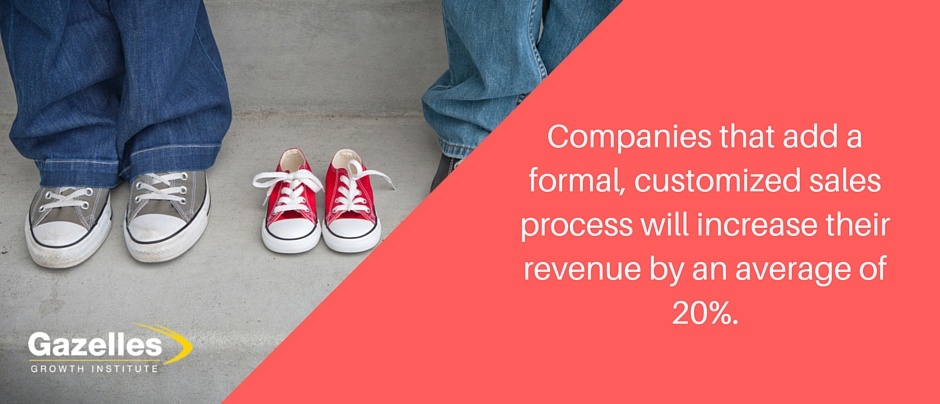Why A Customized Sales Process Is Like Buying Shoes

The science says that companies that add a formal, customized sales process and hold their salespeople accountable to following that sales process will increase their revenue by an average of almost 20%. More on that in a moment, but first, let’s talk shoes.
My wife loves shoes – she has dozens of pairs for every possible occasion and outfit. My son loves sneakers – he not only needs pairs of size 11’s for basketball, turf, baseball, and running, he needs them in various colors to match his many sports uniforms and he outgrows them every other month! I have always managed to get by with a brown and black pair of dress shoes, a pair of sneakers, a pair of dock shoes, and a pair of sandals. My mental review of shoes got me thinking about how well various shoes compare with the sales processes that companies have shared with me prior to creating a new process for them.
In my experience, I have seen customized sales processes in the following forms of shoes:
Sandals – they have some steps but there are so many holes that you can’t really call it a process
Deck Shoes – their process tends to take on water because too frequently the opportunities that they believe will close end up sinking.
Sneakers – their process features a demo which they run to way too frequently and much too quickly.
Loafers – from a distance it appears to be a process but when you look closely, it isn’t ready for formal selling to the C-Suite
Dress Shoes – a formal, custom, staged, visual, milestone-centric sales process that is both comprehensive and predictive, while at the same time, easy enough for all salespeople to follow.
Unfortunately, the only sales processes I have seen that fall into the dress shoe category are those that we have created and optimized for our clients.
You wouldn’t attend a gala in deck shoes, you wouldn’t dine in a special-occasion restaurant wearing sneakers, and you wouldn’t attend a wedding reception in sandals. If your target audience is management or higher, the sales cycle takes more than a week, you’re not selling an online subscription, there is competition, and every sale is important, then you must have the customized sales process equivalent to dress shoes!
If you want your salespeople to sell value and not on price, they must be able to sell consultatively, and a consultative approach requires a consultative process. The question is, which process?
I put this short video together to give you a sense of how sales processes differ, how some are not processes but actually methodologies, and how some are much more complete than others.
Let’s get back to the science and ask a question.
If most companies don’t have the proper customized sales process in place, and sales process alone can increase revenue by almost 20%, then why do companies believe that what they have is good enough?
I hate to generalize, but it goes something like this. The CEO has faith in the Sales Leader and has no idea whether the existing process is great, good, fair or useless. The Sales Leader believes for certain that it is good or great and communicates that to the CEO. Why does this happen?
Because sales leaders have large egos and many of them suffer from one or more of the following three self-limiting beliefs:
- DIY (do it yourself) – They believe they must do it themselves because that’s what they were hired to do.
- KIA (know-it-all) – They know everything therefore there isn’t any way that their process could be improved.
- SOW (sign of weakness) – They believe it is a sign of weakness if they go outside the company for help in the area of sales process.
Get your sales process formalized, optimized, and visualized and let it help your salespeople to supercharge the company’s ability to grow revenue today!
If you want to learn more about this topic, Growth Institute offers a short online course. It provides more detailed instruction on how your customized sales process can and should be built.



